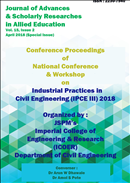Use of Geographic Information System (GIS) for Ground Water Quality Mapping
Evaluation of Groundwater Quality in Wagholi using GIS and Geostatistics
Keywords:
Groundwater quality, Geographic Information System (GIS), Geostatistics algorithms, Temperature, pH, TDS, Total alkalinity, Total hardness, Chloride, Groundwater pollutionAbstract
Groundwater quality is one of the major environmental aspects, depending on the analysis and local distribution of it. If the use of underground management of groundwater resources in Wagholi not only reduces the quality, groundwater quality will be reduced. The purpose of this study is to provide an overview to evaluate ground water quality in the Wagholi area as a case study for frequent delivery using Geographic Information System (GIS) and Geostatistics algorithms.GIS, a tool which is used for collecting, analysing and showing the result spatial data is also used for investigating ground water quality information. The groundwater quality analysis has been made through the temperature (24°C32°C), pH (6.5-8.5), TDS (110-280 mgl), total alkalinity (118-230 mgl), total hardness (230-610 mgl), and chloride (23-85 mgl) from the existing municipal and agricultural wells in Wagholi. Maps of each parameter were created using geostatistical (Kriging) approach. Experimental semi-differential appraisals were tested so that the best fit could be identified for the quality of the ten water samples for drinking quality and the best models would be selected. The basis of mean square error (MSE), root mean square error (RMSE), average standard error (ASE), and root mean square standardized error (RMSSE). Maps of 5 groundwater quality parameters were used to calculate the groundwater quality index (GWQI) map using the index method.GIS will be useful for monitoring and managing groundwater pollution in the field of study. In view of the quality of water, the mapping code for the drinking water was done in the absence of good alternative sources and non-nutrient areas in the study area.Downloads
Download data is not yet available.
Published
2018-04-27
Issue
Section
Articles
How to Cite
[1]
“Use of Geographic Information System (GIS) for Ground Water Quality Mapping: Evaluation of Groundwater Quality in Wagholi using GIS and Geostatistics”, JASRAE, vol. 15, no. 2, pp. 139–143, Apr. 2018, Accessed: Jan. 12, 2026. [Online]. Available: https://ignited.in/index.php/jasrae/article/view/7905











